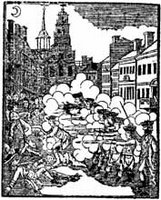 Mid-month, Prof. Al Young, author Ray Raphael, and I carried out a three-way investigation by email into a mysterious remark about the Boston Massacre from shoemaker George Robert Twelve Hewes.
Mid-month, Prof. Al Young, author Ray Raphael, and I carried out a three-way investigation by email into a mysterious remark about the Boston Massacre from shoemaker George Robert Twelve Hewes.As Al describes in his book The Shoemaker and the Tea Party, Hewes was a poor working-man in pre-Revolutionary Boston. At the end of the war for independence he moved to upstate New York. Hewes lived until the 1830s, when two writers discovered him and his store of patriotic anecdotes. Back in the Boston of 1773, he had been just one face in the crowd. (Well, he did inspire his own riot in 1774, but that's another story.) In 1834 and 1835, Hewes was one of a very few men claiming first-hand knowledge of what had happened at the Boston Massacre, the Boston Tea Party, and other events. But how reliable were his statements?
The question for us concerned a passage from Traits of the Tea Party, the second of the two books based on Hewes's memories. On the night of 5 March 1770 Hewes was in the crowd on King Street, surrounding a squad of British soldiers, when those soldiers started firing. Writer Benjamin Bussey Thatcher described how young sailor James Caldwell was shot and fell into Hewes's arms. Then the crowd supposedly carried Caldwell
up to Mr. Young’s, the Jail-House in Prison Lane. He had lived, formerly, next door to old Mr. Sumner’s, but was at this time second mate of a vessel commanded by Capt. Morton. This man lived in Cold Lane, and Hewes ran directly to his house. . . . The corpse soon followed him. . . . Morton…looked upon the dreadful object, and shouted like a madman for a gun, to run out "and kill a regular."Very dramatic, but how accurate? Hewes was speaking of the Boston Massacre sixty-five years after the event. Did he really remember whom Caldwell worked for and even where that man lived? Did he and the crowd really take a wounded man to "the Jail-House," of all places? Perhaps they took Caldwell not to "Mr. Young," whoever he was, but to Dr. Young—physician Thomas Young, a top radical leader. Hiller B. Zobel's The Boston Massacre, still the most definitive study of the event, describes the confusion after the shooting but doesn't say what happened to Caldwell's body.
So we checked original sources, and the picture started to come together. First, I spotted the deposition from merchant Richard Palmes in Boston's report on the event, A Short Narrative of the Horrid Massacre. (As you can tell from that title, the town took a position against the shooting.) Palmes said:
I ran down Exchange lane, and so up the next into King street, and followed Mr. Gridley with several other persons with the body of Capt. Morton's apprentice, up to the prison house, and saw he had a ball shot through his breast.So the crowd did take a wounded man to the prison. I also found a couple of references to Alexander Young as a jail-keeper in the 1760s. So there was our confirmation of "Mr. Young’s, the Jail-House in Prison Lane."
Ray checked his files and located this correction from the 19 Mar 1770 Boston Gazette:
In the account of the funeral procession in our last, it should have been said, James Caldwell was borne from the House of Capt. Morton in Cold-Lane, instead of Faneuil Hall.That let us identify Caldwell as "Capt. Morton's apprentice," whose body Palmes saw taken to the jail. Hewes called him "second mate of a vessel commanded by Capt. Morton"—and indeed the Gazette had earlier identified Caldwell as "mate of Capt. Morton's." So even decades later Hewes was more accurate about another working-class man's employment status than Palmes was at the time. The newspaper correction also put Morton's house on Cold Lane—exactly as Hewes had remembered.
Score another point for the little shoemaker's memory.
ADDENDUM: Identifying Capt. Morton.
No comments:
Post a Comment